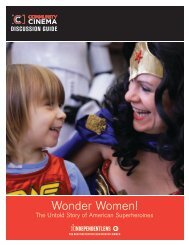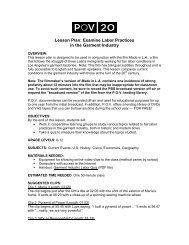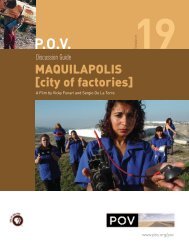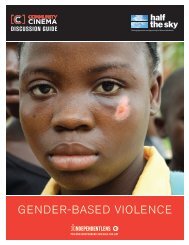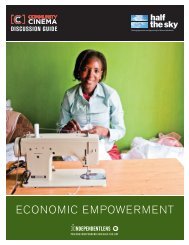HALF THE SKY: MATERNAL MORTALITYStudent Handout F:Case Study #2, Antonia, PeruAntonia had just turned 40. She was the anchor of her family. She’d farmed a small parcel of land andtended livestock with her husband Lorenzo since they were married as teenagers. She gave birth toseven children, ranging in age from two to 18. During her eighth pregnancy when Antonia went into laborthree weeks early, Lorenzo wanted to go to the hospital to get a doctor. Antonia knew it would take himat least two hours to reach the hospital and return with help and was afraid of being alone during thedelivery. So, Lorenzo remained at home and waited.Antonia gave birth to a baby boy, Adolfo, around 6 p.m., but the joywas soon replaced by anguish. Lorenzo, who had assisted Antoniain all her previous births, realized that something had gone wrong.Antonia was bleeding heavily. Lorenzo knew she needed help rightaway. After glancing one last time around his one room adobehome, taking in his wife and his other children shuffling near theirmother’s bed, silent and scared, he left to get help.There are no phones or two-way radios in their tiny village high inthe mountains of Peru’s remote Puno region. The nearest healthpost was a couple miles away traveling on very bad roads. Lorenzoknew from making prenatal visits with his wife there that the onehealth worker wasn’t equipped or trained to handle this type ofemergency. Also, it was Good Friday and he knew that the healthpost was likely closed since it was a holiday.Lorenzo borrowed an old motorcycle and puttered slowly down thesteep, muddied road to the hospital almost an hour away in normalconditions. The drenching rains made the roads nearly impassibleand his transportation broke down half way there. After an hour ofpleading with people in a nearby village for help, Lorenzo managedto borrow a bicycle on which he made the rest of the journey to thehospital. When he reached the hospital, the doctor on call was notthere and the ambulance was in disrepair. After another 30-minutedelay, Lorenzo found the doctor and hired a pick-up truck, and theywere on their way. Unfortunately, the truck got stuck in the mud as itapproached the house and Lorenzo and the doctor had to walk theremaining distance.By the time Lorenzo and the doctor finally arrived on foot just after10 p.m., it was too late. About an hour before, in her mother’s armsand surrounded by her children (including the baby boy she hadjust given birth to), Antonia died.The doctor said Antonia died because the placenta, which helpsnourish the baby in the womb, had blocked her cervix. Shehemorrhaged, which led to cardiac arrest. Antonia’s condition wasconsidered serious, but treatable.In discussions with Lorenzo in the months following Antonia’sdeath, he recounted his schedule: He got up by 4 in the morning tomake breakfast. By 8 a.m. the children left for school and he tendedto the livestock. At around 4 p.m. he came back from dealing withthe livestock to cook dinner. Then he bathed the children and putthem to bed, and he went to sleep about 9 p.m. He was extremelytired, but recognized that this is the schedule Antonia had keptevery day when she was alive.The children suffered without their mother. They only went to schoolsporadically and the younger girls, ages 5 and 9, stopped eatingand were depressed. The oldest son, who had planned to go to thecity for school, dropped out to work in the hazardous gold minesin order to send money back to his family. The second oldest sonwas also forced to drop out of school to help his father aroundthe house and take care of his siblings. Lorenzo had to sell all thelivestock and possessions to pay for baby formula. Having spent allhis money on the baby, Lorenzo’s other children clearly had becomemalnourished and they had no money for school supplies.This case study was excerpted and adapted from the Care report“The Impact of Maternal Health in Peru”www.care.org/campaigns/mothersmatter/downloads/Peru-Case-Study.pdf
HALF THE SKY: MATERNAL MORTALITYStudent Handout F:Case Study #3, Mastbegeen, AfghanistanSangima watched helplessly as her sister-in-law, Mastbegeen, died trying to give birth to her seventhchild. She tells Mastbegeen’s story to and interviewer from Integrated Regional Information Networks,(IRIN) part of the United Nations Office for the Coordination of Humanitarian Affairs (OCHA):Sangima: As you see, we live in this very remote mountain villagein Wakhan District [Badakhshan Province], which is very far fromall facilities, including a clinic. Mastbegeen [her sister-in-law] waseight months pregnant when she started feeling pain. I told mybrother [Mastbegeen’s husband] to find a birth attendant. He tookthe donkey and left the house. After an hour he came back with theold woman.Interviewer: Was the woman a professional health worker?Sangima: She was not from the clinic, but yes she was professionalas she has been working as a midwife for years. She has a lot ofexperience, she is an old woman. There’s no clinic near us and theseold women are the only people who help pregnant women.Interviewer: What I mean is, did she have any formalmidwifery training?Sangima: I don’t think so, because she is very old and illiterateas well. She helped Mastbegeen give birth to the child. After thebirth, Mastbegeen started bleeding. I asked the old woman whatwas happening and she said: “Don’t worry, most women bleed forsome time after giving birth.” Somehow I trusted the old woman, butthen I thought to myself, when I gave birth to my own child I wasnot bleeding like Mastbegeen. I mentioned this to my brother andwe thought we should take her to a clinic. But it was 11pm and thenearest clinic in Khandod [district capital] was six hours’ walk away.We didn’t have any choice but to wait.At midnight, she stopped crying. I bent over her face and shoutedMastbegeen! Mastbegeen! But she didn’t reply. I saw her chestwas moving so I knew she was alive. I left the room to call mybrother, who was helping the old woman to wash the newbornbaby girl. We went back in and found she was dying. We shookher and kept calling out to her, but she didn’t reply and we sawher passing away. It was a very sad scene; I hope no one else onearth has to witness such a calamity in their family. We didn’t knowwhat happened to the baby, but she also died just an hour afterher mother.Now Mastbegeen’s six children are in a very bad state. Sometimes Icome to cook for them or wash them, but still they are not as cleanas other children. My brother cooks, but he can’t cook as well as awoman. He is also poor and can’t provide them with good clothingand food. This is the reality not only in our village, but also in manyremote villages in the Wakhan corridor in Badakhshan, where wehave little or no access to health careThis case study was excerpted and adapted from VEIL OF TEARS: Afghans’ Stories ofLoss in Childbirth Integrated Regional Information Networks, (IRIN) 2009 as part of theUnited Nations Office for the Coordination of Humanitarian Affairs (OCHA)www.irinnews.org/pdf/veil_of_tears.pdf





